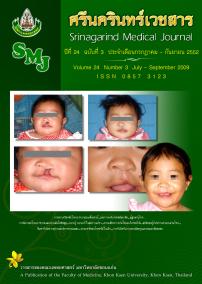ThaiScience
ThaiScience
SRINAGARIND MEDICAL JOURNAL
Volume 35, No. 03, Month MAY, Year 2020, Pages 311 - 319
Efficacy and safety of dispensing system by pharmacy robot and handset electronic picking in hospitalized patients at srinagarind hospital
Piangpen Chanatepaporn
Abstract Download PDF
Background and Objective: The technology machines was used for filling the medicines for hospitalized patients at Srinagarind Hospital. The objective of this study was to evaluate efficacy and safety of dispensing system by pharmacy robot and handset electronic picking. Methods: This was a retrospective descriptive study. Drug prescriptions, dispensing items, waiting time, and dispensing errors were compared between before and after implementation of the robotic medicine and handset electronic picking for continued order items, narcotics and psychotropics category 2 items while other items were filled manually for hospitalized patients. Results: Mean waiting time for overall prescriptions was not significantly different between pre- and postintervention (15.9 vs. 15.5 minutes per prescription). The mean waiting time for continued order prescriptions significantly increased 21.5% (0.7 vs. 0.8 minutes per item). The increased waiting time for continued order items occurred in the process of pharmacist checking since the continued order items increased 51.4% in the post- intervention period (666,888 vs. 1,009,667 items) and drug distribution system was changed from three days dose to one day dose which led to decreasing time for nurse to prepare medications for patients. The mean waiting time for stat order item significantly decreased 14.4% (14.9 vs. 12.8 min utes per item). For other subtype of prescription, no significant change of waiting time was found. Dispensing error significantly decreased 51.1% of prescriptions or 52.3% of items. The largest decrease in dispensing error was found in continued order items (77% decreased). Dispensing errors with severity category B and C decreased 50.3% and 89.1% of items. Conclusions: Implementation of pharmacy robot and handset electronic picking of drug dispensing improved efficacy, dispensing errors, and patient safety for hospitalized patients.
Keywords
Pharmacy robot, Handset electronic picking, Robotic medicineSRINAGARIND MEDICAL JOURNAL
Published by : Faculty of Medicine, Khon Kaen University
Contributions welcome at : http://www.smj.ejnal.com/e-journal/journal/index.php
